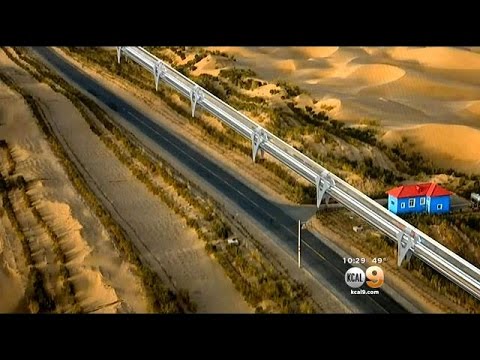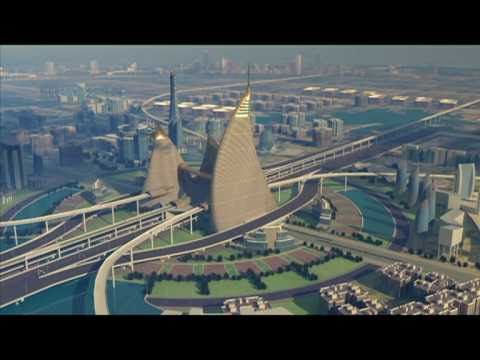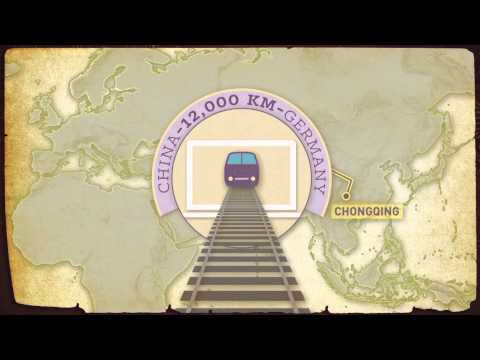10The Chinese Supercity Bigger Than Many Countries
With a land surface area of 790 square kilometers (305 mi2) and a metropolitan area population of over 20 million, New York is considered one of the largest cities on Earth. Jing-Jin-Ji in China laughs in the face of such paltry numbers. A planned project to link Beijing, Tianjin, and Hebei (Jing-Jin-Ji is a play on their Chinese names) into one giant megacity, it would house approximately 130 million people and be bigger than nearly half the world’s countries. Everything about the project is enormous. At an estimated size of 212,000 square kilometers (82,000 mi2), Jing-Jin-Ji will be about the size of Kansas. Or, to put it another way, it will cover a larger surface area and house more people than Austria and Greece combined. It will also require an unprecedented amount of planning. President Xi Jinping has declared that each city within Jing-Jin-Ji will have a special role, with Beijing becoming its cultural and tech district, while Tianjin will be devoted to manufacturing. Hebei will hoover up the remaining smaller industries. High-speed rail networks are already being built to link each of these parts of the supercity in under an hour. Although it sounds like science fiction, Jing-Jin-Ji is well on its way to becoming fact. Work started in 2013. By 2020, the high-speed railways should already be in place. How far this behemoth will grow beyond that point is anybody’s guess.
9The San Francisco–Los Angeles Hyperloop
Before he became famous for trying to single-handedly conquer space, billionaire CEO Elon Musk was making waves with his proposal for a “hyperloop.” A system of pressurized tubes that would propel commuters between San Francisco and Los Angeles at super-high speeds, the idea was initially dismissed as impossible. Reality would beg to differ. In May 2015, a Californian transportation company received the go-ahead to start building the world’s first hyperloop test track. Although it’s in its early days yet, the goal is absolutely to get a track installed between the two cities in the near future. The company has already reached a deal with landowners along Interstate 5 to start construction, and successful tests could result in the thing actually being built. That would revolutionize travel. Moving at just under the speed of sound, the hyperloop would be able to get you from Los Angeles to San Francisco in 35 minutes. For our European readers, that’s like getting from Prague to Strasbourg in less time than your lunch normally takes. Construction on the test track begins in 2016. If it receives the go-ahead, the LA-SF hyperloop could be ready by as early as 2025.
8Nicaragua’s Continent-Slicing Canal
At 77 kilometers (48 mi) long, the Panama Canal remains one of the greatest engineering feats of all time. Yet the continent-cutting canal could be about to lose its crown. In 2014, work began to build a canal three times longer than Panama’s and over twice as deep. Costing around $50 billion, the project would see workers construct a waterway that would slice Nicaragua in half. The brainchild of Chinese telecom billionaire Wang Jing, the Nicaragua Canal will require the removal of more than 4.5 billion cubic meters (160 billion ft3) of earth. As The Guardian put it, that’s enough to “bury the entire island of Manhattan up to the 21st floor of the Empire State Building.” It will also completely upend the Central American nation’s ecosystem. Plans show the canal bulldozing through four separate nature parks, as well across the largest freshwater lake in the region, Lake Nicaragua. Since the lake’s natural depth of 14 meters (45 ft) is only half what’s needed, this will involve dynamiting the lakebed until a 100-kilometer (65 mi) channel can be carved through it. Insane as this is, there’s another, even crazier aspect to the canal. No one wants it. The Chinese government is worried it will strain relations with the US, Nicaraguans are worried it’ll destroy their country, and shipping companies are worried it’ll be ill suited to their needs. Yet it’s going ahead. The most optimistic projections claim the first ship could cross the canal by 2019.
7Tunisia’s Gigantic Solar Farm
The amount of energy the Sun pumps into the Sahara is beyond comprehension. Harnessing a mere 0.3 percent of it would be enough to power Europe for an entire year. Energy company Nur Power is suggesting we do just that. In a proposal put forward at the end of 2014, they outlined plans to build a 100-square-kilometer (40 mi2) solar farm in Tunisia by 2018. The plan involves scattering thousands of computer-controlled solar cells across an area of land roughly three times the size of Macau. These cells would then be used to superheat a central tower, creating steam that would spin a turbine, generating electricity. This would then be run through a 450-kilometer (280 mi) underwater cable to a substation in Italy and, from there, away into Europe. According to The Independent newspaper, the farm could power up to 2.5 million homes in Britain alone. Although it sounds like high fantasy, the plan is already underway. The British government has expressed interest, and Nur Power is hoping to get more countries onboard. However, with the security situation in Tunisia being what it is, it could be a while yet before construction actually begins.
6The Netherlands’ Artificial Mountain
With its liberal sex and drug laws, long life expectancy, and excellent beer, it can be tempting to think the Netherlands has it all. Dutch journalist Thijs Zonneveld disagrees. In 2011, he declared the one thing his low-lying country needed was a mountain. And he was going to make it his life’s mission to ensure it got one. It helped that the Netherlands is no stranger to absurd engineering projects. The province of Flevoland, near Amsterdam, was created in 1932 when Cornelis Lely drained part of the Zuiderzee, expanding the country by several thousand square kilometres. Compared to this and other insane land reclamation projects previously undertaken by the Dutch, a mountain would be easy. Although it was proposed mainly as a joke, Zonneveld’s idea caught the public’s imagination—so much so that the journalist decided to really do it. While construction has still to start as of mid-2015, Zonneveld is committed fully to the project. His official website for the mountain claims his team has spoken with thousands of companies, recruited financiers, and found planning permission. They say they even came close to building a prototype earlier this year. He maintains that his mountain will be built sometime in the decade.
5Saudi Arabia’s Monster Hotels At Mecca
For the past few years, Saudi Arabia has been busy turning the ancient city of Mecca into the Las Vegas of the Middle East. The pinnacle of this transformation may well be the upcoming Abraj Kudai. Technically a luxury, five-star hotel that will loom over the holy city, the Abraj Kudai is so big that it more resembles a vertical city-state, where every citizen will be a guaranteed millionaire. It will stand 45 stories tall, and everything about the hotel screams obscene wealth. The top floor will house one of the largest Islamic domes in the world, surrounded by four helipads for the ultra-rich to land on. At least five floors will be reserved for the exclusive use of the Al-Saud royal family. The rest of the building, meanwhile, will contain around 10,000 bedrooms and over 70 high-class restaurants. Far below, on the ground floors, a vast shopping mall will vie for space with a conference center and a lavish ballroom. Supposedly designed to resemble a “traditional desert fortress,” this monster of a building will cost at least £2.3 billion. Although the Abraj Kudai will be the biggest hotel in the world when it opens in 2017, it pales in comparison to other Mecca projects. A collection of gigantic hotels in the west of the city known as the Jabal Omar development is intended to house 100,000 pilgrims, while the Grand Mosque is to be upgraded to house seven million people at any one time. Ironically, this would stretch so far back that many worshipers wouldn’t even be able to see the Kaaba they’d come all this way to worship.
4China’s Vertical Mega City
Now let’s set our sights beyond that one large hotel. Imagine standing at the base of a building so massive, so self-contained, and so teeming with life that it truly qualified as a city. Right now, preparations are underway for constructing such a sci-fi marvel in the Chinese city of Shenzhen, a booming metropolis on the Pearl River Delta. Known as Cloud Citizen, the finished building would comprise three interlocking towers, the tallest only a few hundred feet shorter than Dubai’s monstrous Burj Khalifa. At around 2 square kilometers (1 mi2), its surface area would be only slightly smaller than all of Monaco. But it’s what’s inside that would really shake urban design up. Rather than just being a supermassive office block, Cloud Citizen is designed to operate as a self-contained city-within-a-city. Alongside homes and offices, the superstructure would contain farms, parkland, food production centers, and the means to harvest rainwater. It would also power itself using a combination of wind, solar, and algae, effectively allowing it to exist separately from Shenzhen proper. Impressively for such an urban building, the focus would be on green spaces and parkland, with commuters encouraged to walk to work through high-altitude sky parks. Although there are no concrete plans to start construction yet, Cloud Citizen is being taken seriously by the local government. It recently won a city-sponsored design competition, and officials are taking an interest in seeing the project realized.
3India’s Gigantic Smart Cities
It sounds like a Silicon Valley dream: a city where everything is connected to the Internet and a central command center digitally links every citizen. Yet this idle daydream may soon be a reality and not in California. Known as Dholera, it’s one of the Indian government’s enormous new infrastructure projects that could be ready within a decade. Part of the phenomenally ambitious Delhi-Mumbai Industrial Corridor, a $90 billion scheme to link the two most important cities on the subcontinent, Dholera would be the jewel in the project’s crown. Built from scratch on reclaimed land, it would be big, powerful, and stunningly high-tech. Digital crowd and traffic control would aim for no jams, no pollution, no mobs of people lining up at terminals, no dirt, and no littering. Every house would be wired up to the Internet, a stunning achievement in a country where, in 2013, only 3 percent of homes had any Internet access. Dholera’s other draw is its size. Designed to cope with India’s ever-expanding population, the city would be twice as big as Mumbai, or roughly three times the size of Malta. Even more impressively, Dholera is just the tip of the iceberg. If the project comes off (and the government is pushing ahead, despite serious setbacks), there are plans to build another 23 smart cities just as impressive across the region.
2Azerbaijan’s Artificial Archipelago
In China and India, they build new supercities. In the Netherlands, they build new mountains. In Azerbaijan, they build new countries. In the waters off the coast of Baku, on the Caspian Sea, whole mountains’ worth of rocks are being poured in to create a new archipelago. Known as the Khazar Islands, the new land will be like a country within its own right. Consisting of 55 separate islands, the archipelago will have its own airport, yacht club, Formula One track, and an 800,000-strong population crammed into its thousands of apartment blocks. More impressive still, the largest island will also be home to Azerbaijan Tower, predicted to be possibly the tallest building on Earth. In 2013, it was estimated to cost $100 billion, significantly higher than the country’s entire GDP. The idea came to billionaire businessman Ibrahim Ibrahimov on a flight back from Dubai in 2010. Lacking a notebook, he drew his designs on some tissue paper and told architects to build them exactly as he’d drawn them. Crazily, they agreed. At time of writing, the Khazar Islands are well underway, with at least one mountain already leveled to provide rocks for their foundations.
1China’s New Silk Road
Stretching from Venice in Europe all the way through Central Asia to the furthest edges of China, the Silk Road was once the greatest trading route on Earth. Unimaginable sums of money moved along its pathways, along with refugees, religions, and Eastern culture. In just a few short years, they might do so again. The Chinese government is determined to bring the Silk Road careering into the 21st century. Known affectionately as the “One Belt, One Road” plan, the idea is to combine a new overland trading route with an expensive new maritime one, through roads, railways, and pipelines. When finished, the road will give China an unbreakable corridor of power and influence stretching all the way from its central city Xi’an to Moscow and Rotterdam. That’s over 10,000 kilometers (6,000 mi) of Chinese dominance, a significantly longer distance than from New York to Buenos Aires. But the project wouldn’t stop there. Aside from linking China, India, and Russia together into the most important economic corridor on Earth, the other half of the plan would see coastal projects and ports connecting China with the rest of Asia and even East Africa. In effect, it would spread Chinese influence out across half the modern world. It’s been described as a bigger investment than the Marshall Plan, and the effects would be world-changing. The craziest part? This monster project could be well underway by 2020.
























